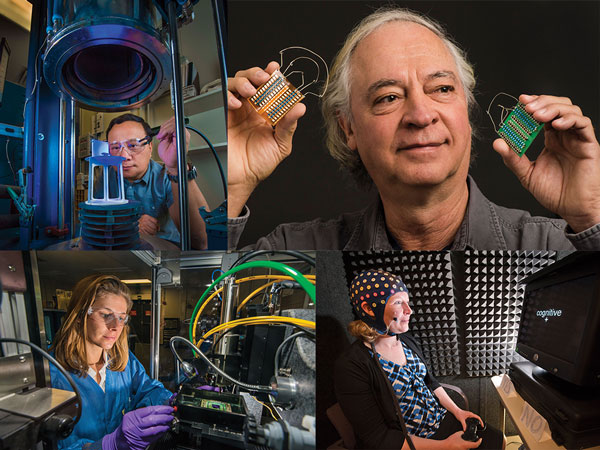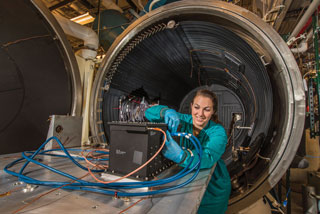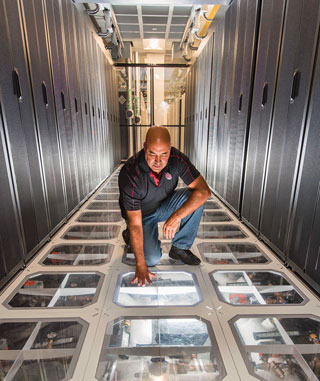Research at a national laboratory is often driven by tight deadlines. But what if a big idea needs more time to go from impossible to possible? A Research Challenge lets it play out and make a difference.

Sandia Labs is a famously mission-driven place. Thousands of scientists and engineers work every day to help the U.S. identify and defeat threats to national security, some nuclear, some chemical and biological, and some just plain terrorism.
Steve Rottler knew it when he took over as chief technology officer and vice president of research in 2009. He also knew that research is vital to carrying out the national security mission. “It was going to be very important for Sandia’s research community to have a sense of strategy that could be married with the mission,” he says. “Research should drive the mission, even as research is being responsive to the mission.”
And an idea was born.
The investment pays off
As Rottler and his team developed a technical strategy for the future of research at the labs, the concept of Research Challenges emerged. “They were intended to be bold ideas that would excite and inspire the research community,” he says. “We wanted to better integrate mission with research and vice versa, and do it in a way that would lead to Sandia being recognized not only as mission oriented, but as a research powerhouse.”
Today Sandia has 11 active Research Challenges, organized and put into action largely by Julia Phillips, Rottler’s successor as chief technology officer. They are designed to produce breakthroughs that impact the mission and contribute in their own right to advancing the frontiers of science and engineering. They are:
- Beyond Moore Computing
- Data Science
- Detection at the Limit
- Engineering Abiotic-Biotic Living Systems
- Engineering of Materials Reliability
- Power on Demand
- Pulsed Power Opportunities for Weapons & Effects Research
- Resiliency in Complex Systems
- Revolutionary Approaches to the Stockpile
- Science and Engineering of Quantum Information Systems (SEQIS)
- Trusted Systems and Communications
The hallmark of a Research Challenge is work that spans a decade or more and cuts across many disciplines, says Rob Leland, who succeeded Rottler as chief technology officer and VP of Science and Technology after Rottler became vice president and head of Sandia’s lab in Livermore, California, and later deputy laboratories director and executive vice president for National Security Programs. “What really sets them apart is the researchers are thinking strategically how to advance a technology across mission areas over a long scale,” he says. “It’s a compelling roadmap that envisions how we get from relatively basic early stage research to something that can have mission impact in a coordinated way using a combination of resources such as Laboratory Directed Research and Development [LDRD] and direct funding from multiple program areas.”

Organize people on a larger scale
Research Challenges are part of a Sandia research strategy that includes the LDRD and Grand Challenge LDRD programs, which award funding through a competitive proposal process. LDRD projects run three years and have potential for strong mission impact. Grand Challenge LDRD projects, also three years, are larger and focus on bold, high-risk high-reward ideas.
The longer-term Research Challenges gain momentum when associated projects win Grand Challenge LDRD support. “We want to see the Research Challenges organize people on a larger scale, and Grand Challenges are one aspect of that,” says Andy McIlroy, Sandia’s deputy chief technology officer and director of Research Strategy and Partnerships. “Many of the successful Grand Challenge proposals are aligned with one or more of the Research Challenges. The proposals maturing out of Research Challenges tend to be particularly compelling and well thought out.”
The LDRD program is funded as a percentage of all the programs that come into the labs, currently at about 6 percent or $155 million a year. About 20 percent of Sandia’s LDRD portfolio is connected to Research Challenges.
Halfway into the 10-year vision, several Research Challenges are showing results and have won Grand Challenge LDRD funding, McIlroy says. The SEQIS challenge around quantum computing has made significant progress by coordinating efforts across a number of research fronts (see Mind boggler article).
“SEQIS is a model Research Challenge. They actually started behaving like a Research Challenge before the concept existed,” McIlroy says. “The fact that we have qubits on a chip and a vision about how to connect those together and create what starts to look like a quantum computer on a chip would have been a big stretch five to 10 years ago. They have accelerated Sandia’s position in that community to where we are viewed as being one of the leading research institutions in quantum computing.”
And Power on Demand (see Super Power article) is moving strongly in multiple directions, propelled by several Grand Challenges, McIlroy says. One of them, on ultra wide bandgap, has published results showing it’s possible to make transistors and diodes from advanced semiconductor materials that could perform much better than silicon, the workhorse of the modern electronics world. The breakthrough work takes a step toward more compact and efficient power electronics, which in turn could improve everything from consumer electronics to electrical grids.
“Their vision is getting out beyond Sandia and having impact,” McIlroy says. “That’s what we want with Research Challenges, something that will make a difference in the world.”
Technical passion and skilled management
Research Challenges organize around technical staff and senior management who have a strong interest in the area. “They bring together the technical passion and some ability and expertise around marshaling and leading a larger effort. The most successful challenges have both those components,” McIlroy says. “What matters most is passion and excitement around the Research Challenge, a vision to drive it forward.”
The teams build organically around the technical and executive leaders. “The strength is the community that comes together,” McIlroy says.
Sandia computer scientist Rick Muller, who works on the SEQIS quantum computing challenge, says it has been a high point of his technical career. It was eye-opening to collaborate with people from different disciplines, he says. “These are the best people I’ve ever worked with,” he says. “The research plan we put together explores new applications of quantum technologies that will be important to Sandia and the nation over the next 10 years, something that was particularly exciting given the team’s diverse strengths.”

A panel of laboratory fellows and senior scientists reviews the Research Challenges each year to see if they are headed in the right direction. “We’re coming to believe there should be an end point to a Research Challenge, maybe 15 years out,” McIlroy says. “If constructed in the purest form, they are trying to address a challenge and at some point we will have gotten there. We’re still trying to tease out what the graduation requirements are. We’re pushing them to have a concrete thing they reach for, a game-changing concept. At some point the work is no longer a challenge but a fundamental part of the capabilities that drive the lab forward.”
Mathematician and computer scientist Tim Trucano, who chairs the review panel, says the value of a Research Challenge is in its power to integrate the lab and provide the time and space to move down a complex path with a goal in mind, at the end delivering compelling, mature and usable research results. “They are essential because of what they’re trying to do,” he says. “This work is critical to the lab and to the nation.”
A pure vision

Leland says the Research Challenges fulfill Sandia’s mission as a Federally Funded Research and Development Center, or FFRDC, by advancing the state of the art in science and technology. “The challenges are a pure expression of that,” he says. “We’re creating a vision to solve a problem that we think has national importance. We figure out how to connect the dots to make that happen and get where we want to go. FFRDCs should be taking a leadership role in pushing the state of the art.”
Rottler says the challenges have helped integrate research at the labs and produced world-class, world-recognized science. “I’m pleased with the trajectory,” he says. “We should continue trying to get better and better. For me there was never a destination. It was and is a journey.”
Leland says the challenges show the value of a national laboratory. “We can address an issue that’s important that might be outside the scope of what people are even thinking is possible today, and pursue it so that in 10 years we’ve got something ready to go,” he says. “People might think, ‘Maybe that’s possible.’ We can say, ‘It’s not only possible, here it is.’ That’s what a national lab can do.”